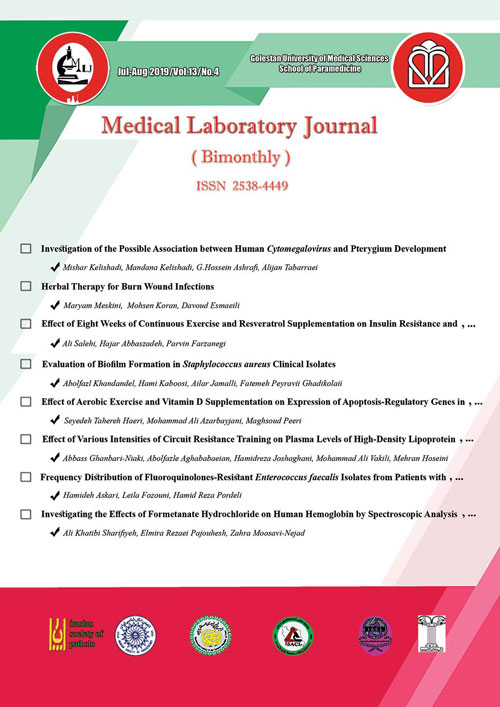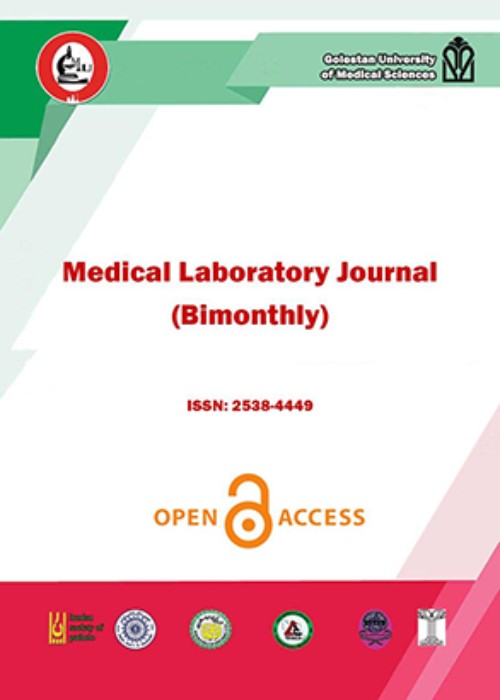فهرست مطالب

Medical Laboratory Journal
Volume:13 Issue: 4, Jul-Aug 2019
- تاریخ انتشار: 1398/02/11
- تعداد عناوین: 8
-
-
Pages 1-4ABSTRACT
Background and ObjectivesPterygium is a common ocular surface lesion that manifest as wing-shaped, benign conjunctival growth, which can extend onto the corneal surface. Presence of some oncogenic viruses in pterygium and the neoplastic nature of the lesion led us to the postulated involvement of the viruses in the etiology of pterygia. The aim of this study was to evaluate prevalence and possible role of human cytomegalovirus (HCMV) in the formation of pterygia.
MethodsFifty pterygium specimens and 10 normal conjunctival biopsy specimens (controls) were investigated by polymerase chain reaction using primers specific for the highly conserved regions of major capsid protein gene of HCMV. Data were analyzed using SPSS statistical software (IBM SPSS Statistics 18; IBM Corporation, USA) at significance level of 0.05.
ResultsThe HCMV DNA was detected in seven (14%) patients with pterygium but in none of the control subjects. All subjects were β-globin positive.
ConclusionGiven the results, direct involvement of HCMV in the development of pterygium seems less probable, thus suggesting that other agents might be involved in the multistep process of the disease.
Keywords: Human Cytomegalovirus, Pterygium, Polymerase Chain Reaction.Keywords: Human Cytomegalovirus, Pterygium, Polymerase Chain Reaction -
Pages 5-7Background and ObjectivesBurns are a major global public health problem, accounting for an estimated 180,000 deaths annually. The majority of burn-related deaths occur in low- and middle-income countries. Considering the importance of treating infected burn wounds with the least adverse effects, we aimed to search the literature to find new treatments for infected wounds using medicinal plants.MethodsThe search process was carried out using various databases including Google Scholar, ScienceDirect, Web of Science, MEDLINE, PubMed, Scopus, and the Cochrane Library. We searched for relevant original and review articles (published in English or Persian) using the following keywords: herbal extract, herbal medicine, burn infection, and wound infection.ResultsOverall, we found approximately 100 articles related to the use of medicinal plants for treatment of wounds or infections. According to these studies, main constituents of plant extracts were carvacrol, flavonoids, terpenoids, phenolic diterpenes, and phenolic acids. Most studies assessed the antimicrobial activity by determining minimum inhibitory concentration and minimum bactericidal concentration using the disc diffusion method.ConclusionGiven the favorable antimicrobial activity of medicinal plants, it is recommended to use them for treatment of burn wound infections.Keywords: Herbal Medicine, Wound Infection, Herbal Extract
-
Pages 8-13Background and objectivesPyruvate dehydrogenase kinase 4 (PDK4) is an enzyme involved in the regulation of glucose and fatty acid metabolism and homeostasis. The purpose of this study was to investigate effects of continuous exercise and resveratrol supplementation on insulin resistance and expression of PDK4 in the soleus muscle of elderly rats with type 2 diabetes.MethodsAfter inducing diabetes in 42 old male rats (mean weigh: 250-300 g, aged about two years), the rats were randomly divided into six groups: healthy control, diabetic control, continuous exercise, supplementation, continuous exercise + supplementation and sham. The continuous exercise group was subjected to eight weeks of running, five sessions a week. Daily 20 mg/Kg body weight resveratrol supplementation was administered to the supplementation and supplementation + exercise groups. To evaluate insulin resistance, the HOMA-IR insulin resistance index was calculated as the product of insulin (μIU/mL) and glucose (mmol/L) divided by 22.5. Expression of the PDK4 gene in the soleus muscle was analyzed by RT-PCR. Data were analyzed with IBM SPSS Statistics 23 using one-way ANOVA and Tukey's post hoc test at a significance level of 0.05.ResultsResveratrol alone or combined with continuous exercise significantly increased PDK4 expression and slightly decreased insulin resistance in the subjects.ConclusionOur results show that diabetes is associated with reduced PDK4 expression and increased insulin resistance. These effects can be effectively reversed in the soleus muscle of elderly diabetic rats by resveratrol supplementation alone or combined with continuous exercise.Keywords: continuous exercise_resveratrol_PDK4_insulin resistance_type 2 diabetes
-
Pages 14-16Background and ObjectivesStaphylococcus aureus is a common cause of nosocomial infections. The ability of S. aureus to form biofilm and acquire antimicrobial resistance has made this organism a major health problem. In this study, we investigate the biofilm-forming ability of S. aureus isolates from clinical samples.MethodsSixty S. aureus isolates from clinical specimens were collected from the 5th Azar Hospital of Gorgan (Iran) in 2018. The isolates were identified using conventional methods including Gram staining and biochemical tests (catalase and coagulase). Biofilm formation by S. aureus isolates was evaluated using a microplate-based method.ResultsOf 60 S. aureus isolates, 47 (78.3%) strains were identified as biofilm-forming and 13 (21.7%) strains were non-biofilm-forming.ConclusionThe high prevalence of biofilm-producing S. aureus isolates in the 5th Azar hospital of Gorgan could pose a major health challenge with serious consequences for hospitalized patients. Therefore, it is crucial to disinfect and sterilize hospital surfaces and equipment effectively to minimize the risk of contamination and spread of bacteria in the hospital settings. Keywords: Biofilms, Staphylococcus aureus, sample.Keywords: Biofilms, Staphylococcus aureus, sample
-
Pages 17-22Background and ObjectivesApoptosis is essential for the survival and normal functioning of multicellular organisms, yet any interruption in this process could be detrimental. Increased production of reactive oxygen species and oxidative stress are key factors affecting apoptosis. Our objective was to determine the impact of exercise with and without vitamin D supplementation on expression of FLIP, Fas, and caspase 8 in lung of rats poisoned with H2O2.MethodsForty-eight adult male rats were randomly divided into six groups: (C), (H), (HD), (HE), (HDE) and dimethyl sulfoxide. Groups H, HE, HD and HDE received 1 mmol/Kg intraperitoneal injection of H2O2. HE and HDE groups ran on treadmill for eight weeks. Expression of FLIP, Fas and caspase 8 was measured in lung tissues using RT-qPCR. Statistical analysis of data was carried out using SPSS 22 at significance level of 0.05.ResultsVitamin D supplementation caused a significant decrease in expression of Fas (P=0.014) and caspase 8 (P=0.016) compared to the control group. However, it significantly overexpressed FLIP in the lung tissues compared to the control group (P=0.005). Exercise with and without vitamin D supplementation had no significant effect on the expression of the apoptosis regulatory genes.ConclusionOur results show that VD exerts protective effects on lung tissue by regulating apoptotic factors. Aerobic exercise alone and combined with VD has no significant effect on the apoptotic factors. These results indicate that VD supplementation can reduce lung injury under oxidative stress conditions.Keywords: Apoptosis, Vitamin D, Caspase8, FLIP, Fas
-
Pages 23-28Background and ObjectivesApolipoprotein O (apoO) is a 198 amino acids protein that exists predominantly in high-density lipoprotein (HDL). It may exert cardioprotective effects via decreasing fat accumulation and increasing removal of cholesterol from macrophages. Although the health benefits of exercise are well documented, no study has yet investigated the effects of various types of training, including resistance training on apoO level. Therefore, we aimed to determine effects of five weeks of circuit resistance training with different intensities on plasma levels of apoO, HDL, total cholesterol (TC) and triglyceride (TG) in young untrained men.MethodsForty-five age- and weight-matched healthy untrained men were randomly assigned to a control group (n=10) and four training groups: training at 20% intensity (n=9), training at 40% intensity (n=8), training at 60% intensity (n=7) and training at 80% intensity (n=8). The subjects performed circuit resistance training at 10 stations (30 seconds at each station) with three repetitions, without rest between stations and with 3-minute active rest between the repetitions. The training was carried out for 45 minutes per session, three sessions a week, for five weeks. Venous blood samples were taken 48 hours before the first exercise session and 48 hours after the last training session. Plasma levels of apoO, HDL, TC and TG were measured using commercial kits. Data were analyzed using repeated measures ANOVA and Tukey's post hoc test at significance level of 0.05.ResultsAfter the training intervention, mean plasma level of TC and TG did not differ significantly between the study groups (P>0.05). Training at 80% of one-repetition maximum (1RM) caused a slight decrease in the apoO concentrations. Moreover, apoO concentration was significantly higher in the 20% 1RM training group compared to other study groups (F=11.599, P<0.002).ConclusionOur results indicate that circuit resistance training at 80% of 1RM can decrease HDL-associated apoO level but does not significantly alter other parameters.Keywords: Circuit resistance training, HDL-O, TC, TG, Young men
-
Pages 29-33Background and ObjectivesEnterococcus faecalis is a major cause of bacterial prostatitis, which can increase the risk of developing prostate cancer if mistreated or left untreated. The aim of this study was to evaluate resistance of E. faecalis strains isolated from patients with prostatitis to three fluoroquinolones.MethodsIn this cross-sectional study, we collected urine specimen from 164 patients hospitalized in six hospitals in the Golestan Province, Iran. Biochemical and bacteriological tests were carried out to identify E. faecalis strains. Pattern of resistance to ciprofloxacin, levofloxacin and norfloxacin was studied using the agar disk diffusion method (Kirby-Bauer method). The broth microdilution test was performed to determine minimum inhibitory concentrations (MICs) of fluoroquinolones according to the CLSI M100-S25 (2015) criteria.ResultsOf 164 isolates, 39 (23.8%) were identified as E. faecalis. Frequency of resistance to ciprofloxacin, norfloxacin and levofloxacin was 12.8%, 12.8% and 2.6%, respectively. The MIC90 of ciprofloxacin against the isolates was 4 μg/ml, which was 4-fold lower than that of norfloxacin (MIC90=16μg/ml) and 2-fold lower than that of levofloxacin (MIC90=8μg/ml). We found no significant difference between the isolates in terms of resistant to the fluoroquinolones (P>0.01).ConclusionOur results show that E. faecalis is one of the most common causes of bacterial prostatitis, and fluoroquinolones are still effective for treating the infection despite the reports of fluoroquinolones resistance in Iran. Moreover, levofloxacin may be a more suitable and effective antibiotic than ciprofloxacin and norfloxacin for treatment of this infection.Keywords: Enterococcus faecalis, Prostatitis, Drug Resistance, Iran
-
Pages 34-41Background and ObjectivesFormetanate hydrochloride is an effective insecticide and acaricide, which is frequently used in citrus gardens. Given its high toxicity, it is necessary to evaluate effects of this insecticide on living factors. In this study, we investigate effects of formetanate hydrochloride on human hemoglobin using spectroscopic analysis and molecular docking modeling.MethodsEffects of formetanate hydrochloride on human hemoglobin were investigated using molecular docking technique and thermodynamic and spectrophotometric methods such as normal and synchronous fluorescence spectroscopy, UV-Vis absorption spectroscopy and circular dichroism.ResultsDecrement of the soret band without any significant shift proved that the insecticide could penetrate into the heme pocket and directly interact with the porphyrin ring. Results obtained from the intrinsic fluorescence spectroscopy and heme degradation study at 321 and 460 nm indicated that formetanate hydrochloride could potentially destroy the heme prosthetic group and eliminate its filtering effect, which results in fluorescence enhancement. The fluorescence study demonstrated a competitive behavior between hydrophobic probe ANS and formetanate hydrochloride for binding to the hemoglobin hydrophobic patches. Results of circular dichroism and synchronous fluorescence spectroscopy confirmed the structural change and polarity alteration around aromatic fluorophores.ConclusionOur findings elucidate that the binding of formetanate hydrochloride to hemoglobin through the heme pocket is energetically much more favorable compared to binding to the hydrophobic central cavity. In addition, formetanate hydrochloride can cause conformational changes in the human hemoglobin and the competitive behavior of this insecticide for the oxygen site can subsequently reduce the oxy form of hemoglobin.Keywords: Hemoglobin, Insecticides, Protein Degradation, Fluorescence


